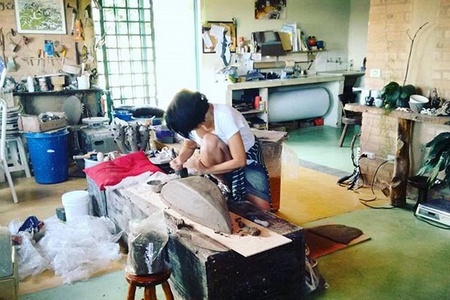Knowledge acquired in Japan when used in clay has the power to create and transform. Nisei Marcelo Yoshinori Tokai, 46 years old, dedicates himself to just that, the art of ceramics. A descendant of Hokkaido and born in Mogi das Cruzes, São Paulo, the artist went to his parents' homeland to delve deeper into traditional techniques and, later, went to the city of Cunha (SP).
Learning in Japan
“My wife Luciane Yukie Sakurada and I studied ceramics in Japan, in Tochigi ken ('province'), Mashiko machi ('city')”, located north of Tokyo. The inspiration to learn the trade comes from family. “My grandfather on my father’s side was a ceramicist,” says Marcelo. Luciane is Sansei and had no contact with ceramics before going to Japan. “We lived for 11 years, from 1996 to 2007, in Mashiko, which is a ceramics hub”.
And he adds: “I studied at the Mashiko Tougei Club, which operates under the apprentice system. It takes more or less four years to learn the entire process. Like offering a ceramics workshop for tourists, I taught there.”
Afterwards, it was time to receive teachings from sensei Masaho Ono, who fires in Noborigama kilns ( noboro means “ramp” in Portuguese and gama , “kiln”) and Masakazu Kusakabe, who is a sensei specializing in kiln construction.
The Noborigama oven was born in China, perfected by the Koreans and incorporated by the Japanese. Built in steps, on a natural slope, it has four interconnected chambers that take advantage of the heat produced in the furnace. The structure of the oven, which has the capacity to reach 1,400ºC, also has a chimney at the back.¹
I live in the ceramics city, Mashiko. I use local materials to make only everyday pottery. I place it on the potter's wheel because it is easier for me to transfer my strong desire to the clay. I fire in a wood-fired oven and a descending oven which can give me more exciting results than I usually expect.²
Masaho Ono
I have compiled a list of ideas that I consider to inform my work. Traditions, the choice of clay, the firing method, the relationship with materials, as well as the harmony between work and the universe are all very important to me.³
Masakazu Kusakabe
Marcelo and Luciane decided to return to Brazil because their eldest son would start going to school and, if he went there, they would never return. “We chose Cunha, because we saw in a report that it was a city of artistic ceramics and Noborigama kilns [where there are currently six in operation] ”, he reports.
The studio

Everything produced at Atelier Gallery Tokai is made by the ceramic couple. “I usually do it on a lathe and my wife does it manually on plates”, explains Marcelo.
The average production is 300 pieces per batch that are fired in a gas oven at 1,300ºC, which provides greater temperature and atmosphere control, providing different colors and textures.⁴ This work takes around two months, depending on the size and complexity of the part. The utilities receive special care – they are covered in enamels with natural elements without heavy metal oxide. The beautiful and zealous result can be seen in the center of Cunha, at Galeria Quinta Essência .
Fascinated by diving, Tokai explores marine flora in sculptures, such as shells and corals. Meanwhile, his wife Luciane has another style, “more rustic and organic”, inspired by nature and the sea.
Culture and language
Since he was a child, the artist has lived with Japanese culture, because his parents are Issei . This is also why they speak little Portuguese. “It’s like this at home, when we talk to our parents, we always speak in Japanese, but a word or two ends up coming out in Portuguese.” With our children, “we tried to speak in Japanese, but we only ended up using a few words,” he says. The oldest – who was born in Japan – understands a little and the youngest sometimes asks: “what is that?” [sic]
Japanese culture was also present in other aspects of Marcelo's life. He even practiced karate , kendo and a little judo .
When it comes to food, the Tokai family is quite different from many Nikkei (who have typical Brazilian and Japanese dishes on the table). Nirá , mitsuba , gobo , shisô , hana umê , miogá , renkon , takenoko and rakyo are PANCs (Non-Conventional Food Plants), but they are part of everyday food. “There’s always umeboshi and miso in the fridge and you can’t miss gohan (unseasoned Japanese rice) at meals – my children won’t eat any other type.” Furthermore, they have the custom of saying itadakimasu before and gotisousama after eating.
The Japanese values that Marcelo follows are respect for elders, commitment to what is promised and arriving ten minutes before the scheduled time. And, to communicate, he discovered a habit or even a characteristic of his own. “I realized that many words I think in Japanese and translate into Portuguese; That’s why I think mine is more Japanese,” he says.
In the role of art dissemination agent, the ceramist considers the dissemination of culture to be extremely important. “I cite, for example, the city where I live, Cunha, where the tradition of making artistic ceramics by the Japanese was introduced. I see the city’s social and cultural development well ahead of others around the [Paraíba] Valley.”
“Japanese, wherever it goes, is not diluted among people, whether in appearance, food or culture. Always stands out. I think this is good and it is important to preserve and pass it on to our children”, he concludes.
Ceramics in Cunha: from Japan to Brazil
The community of ceramicists in Cunha was born in 1975, with the arrival of Portuguese architect Alberto Cidraes, and Mieko Ukeseki and her husband.⁵
Upon meeting in a small village of ceramic artists in Fukuoka province, Cidraes invited his new colleagues to create a group in Brazil similar to those in Japan, but with full artistic freedom and a strong character of experimentation.⁶
They were joined by apprentices from Grupo do Matadouro, whose studio favored local materials and low technology in the production process, and others who had arrived since the 1990s.⁷
Today, the city has more than 20 ceramic artists' studios and has the highest concentration of the traditional Japanese Noborigama kiln in South America.⁸
References:
1. Artisans from Cunha, SP, create pieces of singular beauty and transform ceramics into a tourist attraction and Ceramic Atelier
2. Cultural Confluence wood Fire Symposium
5 – 6. MORAIS, Liliana Granja Pereira de. “ Mieko Ukeseki from Japan to Cunha (SP): trajectory of a woman ceramicist between two cultures ”. Thesis (Master’s). University of São Paulo, São Paulo, 2013.
7 – 8. The Ceramic Cultural Institute of Cunha
© 2019 Tatiana Maebuchi






